JARS v64n4 - Kurume Azaleas
Kurume Azaleas
Akihide Okamoto
Kurume, Fukuoka, Japan
Revised text from that published in Rhododendron Species 2009, Vol. 4, Rhododendron Species Foundation and Botanical GardenIntroduction
Kyushu, the southwestern main island in the Japanese archipelago, is the native home of the primary parent azalea species of the well-known Kurume azaleas, with the city of Kurume being the center of their breeding from very beginning. The Kurume Vegetable and Flower Research Station, National Agricultural Research Center for Kyushu Okinawa Region was founded in 1947 in Kurume City, Fukuoka prefecture, as a Japanese government research institute for breeding and developing cultivation techniques for vegetables and flowers. The institute conserves 850 cultivars and 1,000 accessions of 20 wild species distributed in Japan, Korea, and Taiwan, and plays a major role in preserving the gene bank of evergreen azaleas in Japan.
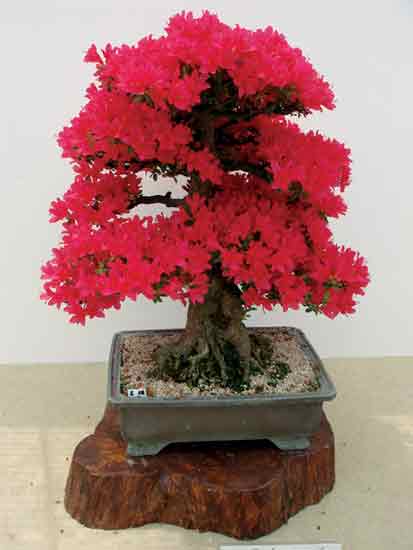
|
|
Photo 5. 'Wakakaede'
Photo by Akihide Okamoto |
History of Kurume Azalea
The Kurume Azalea is a brand name of the Kirishima azalea ( Rhododendron Obtusum Group) and is called for the cultivars bred in Kurume City. Kurume azaleas are said to have originated in about 1840. Mr. Motozou Sakamoto, a retainer of the Kurume clan, discovered "the method of germinating seeds on moss" and many Kurume azalea cultivars are bred through artificial pollination. In the horticultural book Kurume Tsutsuji Shi written by K. Akashi (1905), 128 cultivar names were recorded in 1849. At the time, the pinkish flowers and hose-in-hose type were popular. Many people enjoyed bonsai inside their houses, where the light is not as bright as outside, and pinkish flowers reflected brilliantly under dim light condition. The hose-in-hose flowers lasted longer than the usual single flowers because of their having no seeds.The Kurume azaleas are characterized by medium-small to small flowers of bright color. The flower bud contains two to three flowers. In some cultivars, plural flower buds grow on one branch. Flowering is earlier than the development of new spring leaves and stems. The flowers cover the entire plant, so full appreciation of its beauty requires viewing the whole plant rather than focusing on a single flower. In Japan, Kurume azaleas are used extensively for garden and commercial projects such as public parks and street planting, as well as for bonsai and container use.
From about 1910 to 1930, Kurume azaleas were exported overseas to places such as the United States, the Netherlands, Italy, Australia, Taiwan, and the Philippines. In 1915, the Akashi Kourakuen Nursery exhibited them at the Panama Pacific Exposition in San Francisco. E. H. Wilson visited the nursery in 1918 and selected and introduced 50 cultivars to the Arnold Arboretum - the so-called "Wilson's fifty" (Table 1). These were only about 20% of the cultivars then made by horticulturists in Kurume City.
Table 1 . Wilson's Fifty (the cultivars bred by Motozou Sakamoto and fellow enthusiasts underlined). Note: Japanese and English names would normally be between quote marks, but for clarity here, these are not included. Names in parentheses are corrected Japanese spellings. Wilson's No. Japanese name English syn. name Flower type Flower color 1 Seikai Madonna hose-in-hose, large yellowish white 2 Kure-no-yuki Snowflake hose-in-hose white 3 Shin-sekai (Shin Seikai) Old Ivory hose-in-hose, large yellowish white 4 Yoro-zuyo Purity single, small, tubular white 5 Nani-wagata (Naniwa gata) Painted Lady single pale pink, light center 6 Tancho Seraphim hose-in-hose pink, light center 7 Hachika-tsugi (Hatsukatsugi) Prudence single purplish pink 8 Irohayama Dainty single, large white, margined light purple 9 Ho-o Apple Blossom single white, tinged purplish red stripes 10 Sui-yohi Sprite single pink 11 Takasago Cherryblossom hose-in-hose pink 12 Kasumi-gaseki Elf single pale pink, light center 13 Bijinsui Little Imp single yellowish pink 14 Asa-gasumi Rosy Morn hose-in-hose pale purplish pink, purplish red stripes 15 Kimigayo Cherub single pink, light center 16 Azuma-kagami Pink Pearl hose-in-hose, large pink 17 Osaraku Penelope single purplish pink, light center 18 Otome Maiden's Blush single pink, light center 19 Aya-kanmuri Pinkie single purplish pink 20 Shintoki-no-hagasane (Shin toki-no-hagasane) Rose Taffeta hose-in-hose pink 21 Saotome Peachblossom single purplish pink 22 Kirin Daybreak hose-in-hose, tubular pink 23 Tama-fuyou (Tamafuyo) Fancy single pink, light center 24 Kiritsubo Twilight single light purple 25 Omoine Dame Lavender single light purple, light center 26 Oino-mezame Melody single pink 27 Katsura-no-hana Ruth single purplish pink 28 Shin-utena Santoi single yellowish pink, light center 29 Kumo-no-uye (Kumo-no-ue) Salmon Prince single pink 30 Beni-fude Sunbeam single pink 31 Suga-no-ito Betty single pink 32 Kasane-kagaribi Rosita hose-in-hose dull yellowish pink 33 Tsuta-momiji Cardinal hose-in-hose, large pink 34 Suetsumu (Suetsumuhana) Flame single, small reddish pink 35 Fude-sute-yama Poppy single dull red 36 Ima-shojo Fascination hose-in-hose, small red 37 Rashomon Meteor single vermilion 38 Waka-kayede (Wakakaede) Red Robin single, large purplish red 39 Yaye-hiryu (Yae hiryu) Scarlet Prince hose-in-hose vermilion 40 Kurai-no-himo Carmine Queen hose-in-hose, large purplish pink 41 Agemaki Jose single purplish pink 42 Hinodegiri Red Hussar single purplish red 43 Aioi Fairy Queen hose-in-hose reddish pink 44 Sakura-tsukasa All-a-glow single light purple 45 Tama-no-utena Flamingo single yellowish pink, light center 46 Gosho zakura Vanity single purplish pink, light center 47 Ukamuse Princess Delight single vermilion 48 Hinode-no-taka Ruby single purplish red 49 Osaraku Seedling Winsome single light purple, light center 50 Hana-asobi Sultan single, small reddish pink Wilson's fifty falls into four categories:
(1) 19 cultivars bred by Motozou Sakamoto and fellow enthusiasts from the Tenpo (1830-1843) to the early Meiji (1868-1912) era - the so-called "primary Kurume Azalea" in Japan.
(2) 29 cultivars bred from the Meiji era to the Taisho (1912-1926) era.
(3) Edo Kirishima azalea 'Hinodegiri'.
(4) Wilson-selected seedling from the Akashi Kourakuen Nursery, named 'Osaraku seedling'Some name corrections in standard reference books should be noted - the ones mentioned here, among others, will be communicated to Dr. A.C. Leslie, International Rhododendron Registrar. In the section " Rhododendron obtusum f. japonicum " of "A Monograph of Azaleas" written by E.H. Wilson and A Rehder (1921), and repeated in the IRRC (2004), 'Hachika–tsugi' and 'Nani-wagata' should be respectively called 'Hatsukatsugi' and 'Naniwa gata', and 'Shin-sekai' should be called 'Shin seikai'. The flower type of 'Takasago', 'Kasane-kagaribi' ('Kasane kagaribi') (stated as single also in the IRRC (2004)), and 'Tsuta momiji' are hose-in-hose, and 'Ukamuse' is single, not hose-in-hose (stated as both single and hose-in-hose in the IRRC (2004)).
In the table of "Wilson's fifty" in Azaleas written by F.C. Galle (1987), 'Yaye Hiryu' ('Yaye-hiryu', or 'Yae hiryu') is described with Edo Kirishima azalea 'Yayi-giri' as a synonym (P. 179 in Galle), but 'Yayi-giri' ('Yayie giri', or 'Yae kirishima') should not be a synonym, as the latter has a different flower type and is an Edo Kirishima azalea (the distinction between these names is given later).
During the 1960s, the use of Kurume azaleas for landscaping public places expanded considerably in Japan. As a result, both demand and production were greatly increased. In 1977, according to a report published by Fukuoka Prefecture, 81 cultivars were especially recommended (Table 2), with different cultivars recommended for different purposes. For instance, according to Japanese criteria, for use as bonsai it should easily grow a tree trunk; the leaves should be small, glossy, and thick; the flower should be without a blotch; and the pistil and stamens should be white. On the other hand, for usage in public landscaping, cultivars should have great vigor, flower colors should be bright, blooming should be earlier, plants should be tolerant of drought and wet, and they should be easy to propagate by cuttings.
Table 2. Recommended cultivars for agricultural production by Fukuoka Prefecture (1977). Note: Names would normally be between quote marks, but for clarity here, these are not included. Names in parentheses are corrected Japanese spellings, and underlined names are in the IRRC but are not registered. Flower color Cultivar names White Kure-no-yuki Hatsu ume* Mizu-no-yamabuki Matsu-no-yuki * Mado-no-tsuki * Seikai Hakutsuru Pink Neya-no-ogi* Kumo-no-uye Takasago Konohana * Kirin Tama-no-koshi* Nanwa gata (Naniwa gata) Azuma-kagami Atsum zakura * (Atsumi zakura) Iwato kagami Tsuta-momiji Hatsune Waka-yebisu* (Wakaebisu) Bezaiten* Maihime Fuji-no-asahi Akebono Dai kirin* Hinode-no-kumo Yoshinoyama Yoshimi dake* Fude-dome* Komachi Mikaera-zakura (Mikaeri zakura) Kimigayo Kumoi zuru* Shuchu-ka Shiranui* Otome Tennyo-no-mai Beni-kirin Purplish pink, Purplish red Agemaki Suetsumu (Suetsumuhana) Waka-kayede (Waka kaede) Miyagino Hana asobi Kurai-no-himo Hinode-no-taka Vermilion Hino-tsukasa Asahizuru Fukuju Ukamuse Aya- hime Aratama * Rankyoken (Rangyoku) Red Ima-shojo Purple Kocho-no-mai Susogonoito Kokonoe Irohayama Ko-murasaki Ouchiyama Yozakura Kunimitsu * Ademurasaki * Ima-murasaki * Mayabunin* Usuyukari * Flecked Fukuhiko Tokoharu Shizu-no-mai * Tokonatsu Gunki * Nishiki kujaku* Hakuo-nishiki * Ezonishiki * Miyako bijin* Murasame Kara-nishiki Mihata-nishiki Nishiki tsukasa* Narumi gasane* Yamato nishiki* Miyako-shibori Although 732 cultivars of Kurume azalea have been found in horticultural books and seedling catalogs over the years, some have become extinct due either to their lack of popularity or the fact that they were seldom or never propagated. Moreover, some cultivars were never allowed to be taken out of special member collections and have consequently disappeared. Nowadays outdoor culture is more common than in the past, so cultivars that are slow-glowing or have less vigor tend not to be produced, although they may have beautiful flower color or be desirable in other ways. At present, seven cultivars for public landscaping and 30 cultivars for container use are produced by commercial azalea growers in Kurume City (Table 3).
Table 3 . Kurume azalea cultivars found in published sales catalogues of production groups in Kurume City (2000–2006). • indicates cultivars produced for public planting. Note: Names would normally be between quote marks, but for clarity here, these are not included. Names in parentheses are corrected Japanese spellings, and underlined names are in the IRRC but are not registered. Cultivar name Flower type Flower color Use Landscape Bonsai Beni-fude single pink x Benikasuri single reddish purple, light center x • Chikushi beni* single red x Fukuju double hose-in-hose dull red x Futae tokonatsu* hose-in-hose white and purplish red flecked x • Hana-asobi single, small reddish pink x x Hachika-tsugi (Hatsukatsugi) single purplish pink x Hinode-no-kumo single pink, tinged reddish pink stripes x • Ima-shojo hose-in-hose, small red x x Irohayama single white, margined light purple x Miyako bijin* hose-in-hose white and reddish pink flecked x Mizu-no-yamabuki hose-in-hose yellowish white x Ogi-no-odorikarki (Ogi-no-odorikarako) single vermilion x Oino-mezane (Oino mezame) single pink x x Omoi-no-sora * single light purple x Sakura komachi * single pink x Shin-miyagino hose-in-hose pink x x Shintoki-no-hagasane (Shin toki-no-hagasane) hose-in-hose pink x • Shin tokonatsu* single white and purplish red flecked x x Surusumi single light purple x Susogonoito single purple x x Tennyo-no-mai single pink, light center x • Waka-kayede (Wakakaede) single purplish red x x Yozakura single purple x The Origin of Kurume Azalea
If the evergreen azalea species that have purple flowers are crossed with vermilion flowered species, different color forms are produced. Purple-flowered R. kiusianum , distributed in the high mountains of Kyushu, can cross with the vermilion flowered R. kaempferi , found at the foot of the mountains. Groups of natural hybrids of the two species can thus be found at intermediate elevations where the two species co-habit, with flowers that are purple, pink, and vermilion.The parental species of Kurume azaleas are generally R. kiusianum , R. kaempferi , and R. sataense . 'Susogo-no-ito'* ('Susogono ito') (Photo 1) and 'Kocho-no-mai' ('Kochouno mai') have small purple flowers, small leaves, and short branch length. The shrub is compact, showing a similarity to R. kiusianum . 'Kumokiri'* (or 'Kumo Giri'*) (see Galle 1897, P. 177) and 'Sakura gasane'* ('Sakuragasane') resemble R. kaempferi, and 'Kure-no-yuki'* ('Kureno yuki') resembles R. sataense . Y. Kobayashi (1980) stated that the important anthocyanin of the Kurume azaleas was derived from the cyanidin of R. kaempferi and R. sataense , peonidin from R. sataense , and malvidin from R. kiusianum and R. sataense . I. Miyajima et al. (1985) indicated that among all three species, R. kaempferi , R. kiusianum , and R. sataense , only R. kiusianum had 5-methyl flavonol, and that 5-methyl flavonol existed in both purple- and reddish purple-flowered Kurume azalea cultivars. There is also, however, a relationship between the Kurume azaleas and two other Japanese species, R. macrosepalum and R. ripense . One theory is that the parent of the white Kurume azalea 'Tago-no-ura' (Photo 2) is 'Shiro-ryukyu' ('Shiro ryukyu') ( R. mucronatum ). 'Shiro-ryukyu' has white, medium-large size flowers. It is an evergreen azalea thought to be a hybrid of R. macrosepalum and R. ripense . Among the results of analysis of both the micromorphological characters of leaves and the isozymes of flower buds, which are used to study species classification and interbreeding, 'Tago-no-ura' ('Tagonoura') has the special features of the leaf epidermis of both R. macrosepalum and R. ripense , and the particular aspartate aminotransferase isozyme of R. ripense . Unfortunately, chloroplast DNA is the same haplotype as R. kiusianum .
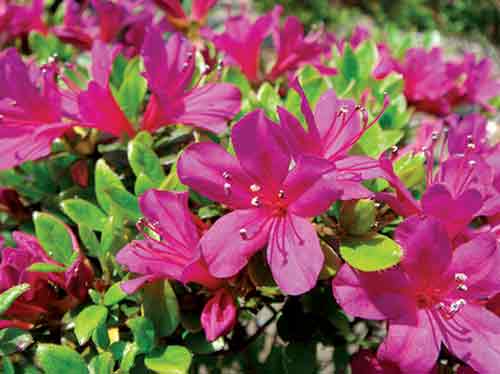
|
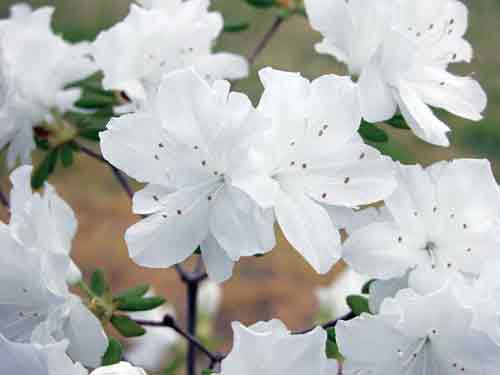
|

|
||
|
Photo 1. 'Susogonoito'*
Photo by Akihide Okamoto |
Photo 2. 'Tagonoura'
Photo by Akihide Okamoto |
Photo 3. 'Hanaikada'
Photo by Akihide Okamoto |
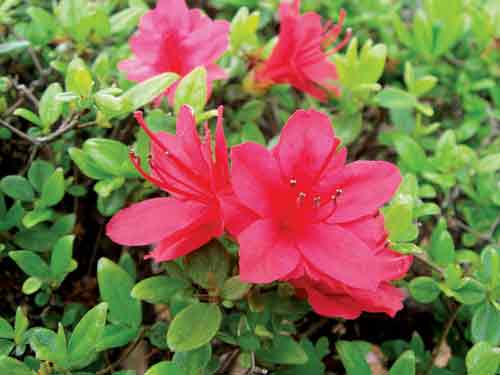
|
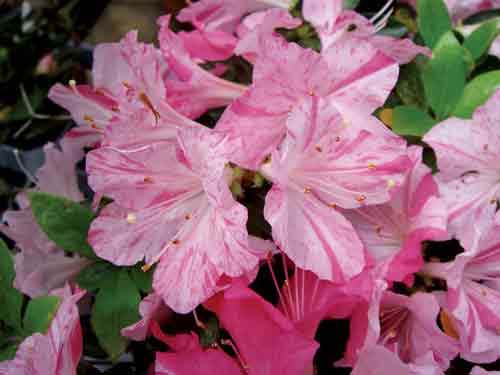
|
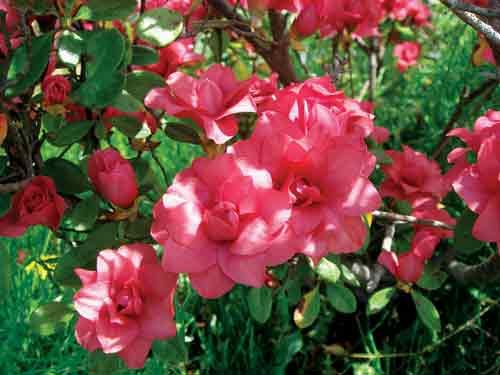
|
||
|
Photo 4. 'Ima shoujou'
Photo by Akihide Okamoto |
Photo 6. 'Fukuhiko'
Photo by Akihide Okamoto |
Photo 7. 'Fukuju'
Photo by Akihide Okamoto |
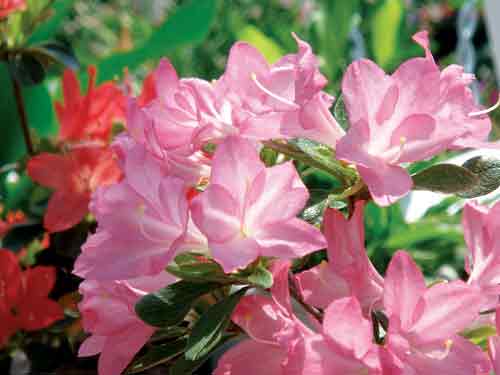
|
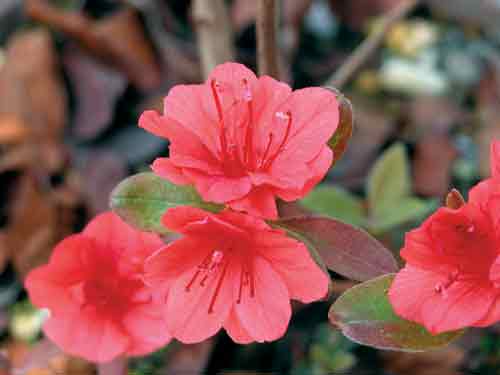
|
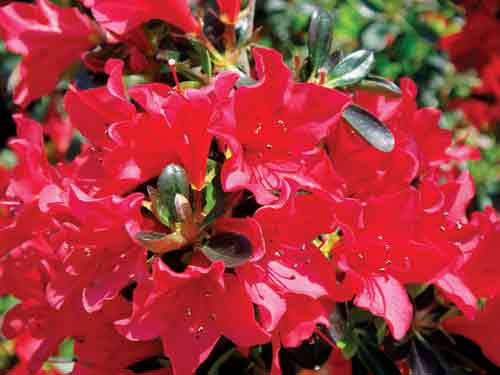
|
||
|
Photo 8. 'Genroko'*
Photo by Akihide Okamoto |
Photo 9. 'Yae hiryuu'
Photo by Akihide Okamoto |
Photo 10. 'Chikushi beni'*
Photo by Akihide Okamoto |
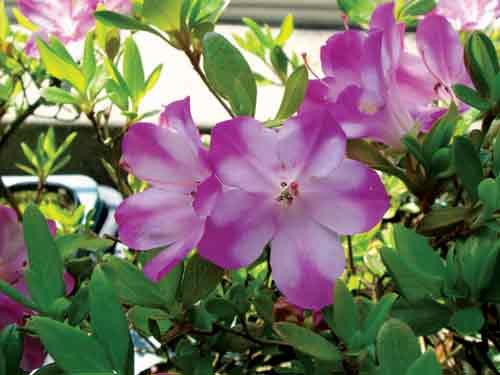
|
|
Photo 11. 'Beni kasuri'
Photo by Akihide Okamoto |
The Special Features of Kurume Azaleas in Comparison with Edo Kirishima Azaleas
The morphological and cultural characteristics of Kurume azaleas and Edo Kirishima azaleas resemble each other. However, the process of development of the two groups is different, and the plants overall are generally very different from each other. Here I compare the special features of the Kurume azalea with those of the Edo Kirishima azalea.The Edo Kirishima azalea was discovered about 350 years ago. Since the Seiho era (1644–1647), natural hybrids found near the Kirishima Jingu Shrine, Kagoshima (city at the southern Kyushu), that were taken to Edo (Tokyo) became the Edo Kirishima azaleas. In contrast, Kurume azaleas are the artificial hybrids from wild plants distributed in the mountains of southern Kyushu, Edo Kirishima azaleas, and 'Shiro-ryukyu'. There are many more forms of Kurume azaleas compared with the Edo Kirishima azaleas.
Vermilion cultivars are numerous in Edo Kirishima azaleas. Kurume azaleas exhibit a continuum from purple to pink to vermilion. Furthermore, in 'Hanaikada' (Photo 3) and 'Irohayama' ('Iroha yama'), the tips or edges of the petals are deep colored and the centers are white. This is one of the most prominent features of the Kurume azaleas. These cultivars are plants intended for enjoyment in the interior of a house rather than in the open air, i.e., to be effective in subdued light. The flowers are very refined, with shades of flower color that would be lost in a landscape. Some are very intensely colored flowers, such as 'Ima-shojo' ('Ima shoujou') (Photo 4), 'Kocho-no-mai' ('Kochouno mai'), and 'Waka-kayede' ('Wakakaede') (Photo 5) and are used outdoors at present. There are also streaked and flecked flowers shibori saki, such as 'Fukuhiko' (Photo 6) and 'Shin-tokonatsu'* ('Shin tokonatsu').
As for the Edo Kirishima azaleas that have little variation in flower color, there are many cultivars with particular flower shapes. These are the same color as 'Hon kirishima'*, but names of the different flower forms are prefixes to "kirishima", for instance 'Yae (single hose-in-hose)-kirishima', 'Mino (single hose-in-hose with skirt-like appendage) kirishima'*, 'Sen-e (double hose-in-hose) kirishima'*, and 'Kikyo-zaki (single, sharp tip of the petal) kirishima'*. In the Kurume azaleas there are also many cultivars that are single hose-in-hose, as well as single, but their names do not describe their forms. Unusual flowers also exist, such as those of 'Fukuju' (Photo 7) which is double hose-in-hose, 'Genroku'* (Photo 8) which has no stamens, and 'Yaye-hiryu' ('Yae hiryuu', Photo 9), which has more than 10 stamens but no ovary. Because 'Yaye-hiryu' is even more unusual in having no ovary and with an abscission layer between the style and peduncle, the flower drops off at the end of flowering. Different from the usual hose-in–hose, this feature, not to retain the spent flowers, is a valuable genetic resource.
Kurume Azalea Cultivars Bred in Recent Years
Recently new special features have been achieved by hybridizing Kurume azaleas with other groups, thereby producing interesting cultivars that strictly cannot be called Kurume azaleas.I describe two cultivars raised in Kurume City since 1990:
(1) 'Chikushi beni'* (Photo 10) was bred by the Kurume branch, National Research Institute of Vegetables, Ornamental plants and Tea (currently called the Kurume vegetable and flower research station, National Agricultural Research Center for Kyushu Okinawa region) and was registered at the plant variety protection registry (Ministry of Agriculture, Forestry and Fisheries in Japan) in 1991. The seed parent was 'Karafune', which has no provenance or history, and the pollen parent was the Kurume azalea 'Waka-kayede'. The flower is single, with wavy petals. Flower color is a vivid red, previously not seen in Kurume azaleas. The blooming time is midseason and branch length is vigorous. The plant is useful for public plantings, gardens, and cut flowers.(2) 'Beni kasuri' (Photo 11) was bred by the Azalea foundation center, Kurume city, and registered at the plant variety protection (Ministry of Agriculture, Forestry and Fisheries in Japan) in 2000. The seed parent is Kurume azalea 'Iroha yama', and the pollen parent is 'Hoshi kagami'* (see Galle 1987, P. 273; note the hybridizer is Kuwano, not Kuwana), a hybrid between a Kurume azalea and a Kurume Satsuki azalea. The flower is single and the edges of the petals are reddish purple, with a pale pink center and a particular shibori saki (splashed pattern). If the plant is grown in direct sunlight or given too much fertilizer, the shibori pattern fades and is not clearly displayed. The plant blooms midseason, and is good for container plants as well as domestic garden use.
Events and Institutions Relating to Kurume Azaleas in Kurume City
In Kurume City, there are various facilities and events to attract tourists. Here I introduce some typical examples:
(1) Kurume Azalea Festival (Photo 12). This event has taken place every year since 1957 in the Kurume Hyaku-nen Park, from April 5th to May 5th. It is one of Japan's three major garden festivals. About 400,000 people visit each year.
(2) Kurume Hyaku-nen Park (Photo 13). This park is built to celebrate the 100th Anniversary of the municipality of Kurume, and is 10.4 ha (25.7 acres). Kurume azaleas, Satsuki, and other Japanese evergreen and trifoliate azaleas are planted. The flower viewing takes place around April 20th, during the Kurume Azalea Festival.
(3) Kurume Azalea Forest Park is a park of six ha (14.8 acres) on sloping ground at an elevation of about 300 meters (984 ft). About 60,000 plants of 100 Kurume azalea cultivars have been planted. The peak of flowering is around May 1st, after the flowering is finished below on the plain of Kurume City. From the park it is about one km (0.6 mi) to the Koura Taisha shrine, where there are about 200 plants of Edo kirishima azaleas, estimated to be about 300 years old.
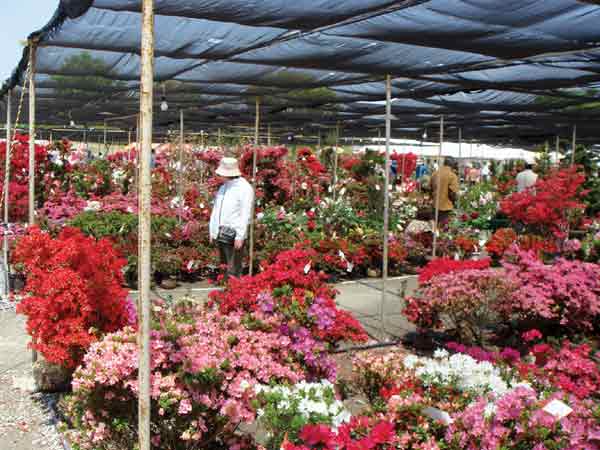
|
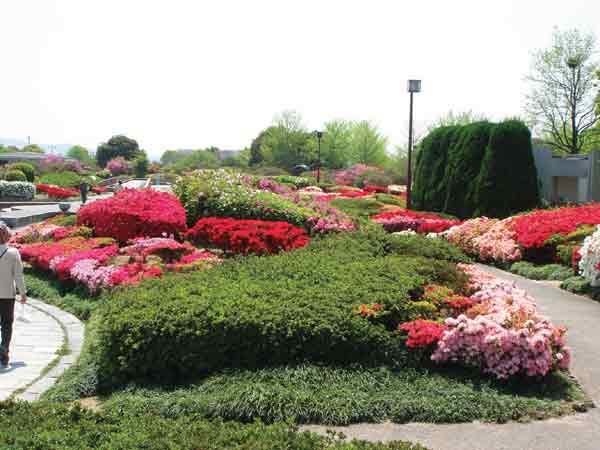
|
|
|
Photo 12. Kurume Azalea Festival.
Photo by Akihide Okamoto |
Photo 13. Kurume Hykunen Park.
Photo by Akihide Okamoto |
In Conclusion
Currently the existing cultivars of Kurume azaleas are maintained in Kurume City by hobbyists and nurseries as bonsai and garden specimens, and also in public landscapes. However, with the aging of many of the most enthusiastic hobbyists, changes in each generation of the nurseries' management, and rationalization of research facilities, it will be difficult to preserve all the cultivars now extant.* = not registered. Names in parentheses are corrected Japanese spellings from those listed in the IRRC.

Akihide Okamoto is a scientist with the National Agricultural Research Center for Kyushu Okinawa Region, Kurume, Fukuoka, Japan.Author's note: I do not know of the IRRC, and in Japan, some scientific journals (e.g., Journal of the Japanese Society for Horticultural Science, and Horticultural Research (Japan)) do not use the IRRC. There are more than 300 cultivars of Kurume azalea at present. Many azalea researchers and hobbyists even in Japan do not know them all. Similarly, I do not know all the Satsuki cultivars. In Japan, many evergreen azalea cultivars exist: e.g., Ryukyu azaleas, Mochi azaleas, Okirishima azaleas, Oyama azaleas, Edo kirishima azaleas, Hirado azaleas, Kiusianum azaleas and Satsuki. I guess that many Japanese cultivar names are not registered in the IRRC.
References
Akashi, K. 1905. Kurume Tsutsuji Shi.
Galle, F.C. 1987. Azaleas . Timber Press, Portland, Or.: 519 pp.
IRRC. 2004. The International Rhododendron Register and Checklist, Second Edition. Two Volumes. Royal Hort. Soc., London: 1544 p.
Kobayashi, Y. Studies on the flower colour in Rhododendron. 2. On the development of Kurume azaleas. Bull. Fukuoka Hort. Exp. Sta. 18:33–40 (in Japanese with English summary).
Miyajima, I., Uemoto, S., Kuwahara, K. and Arisumi, K. 1985. Flower color variation of Rhododendron sataense and wild azaleas in Kirishima mountain mass. Abst. Japan. Soc. Hort. Sci. Autumn Meet.: 302–303 (in Japanese).
Wilson, E.H. and A. Rehder. 1921. A Monograph of Azaleas. Rhododendron Subgenus Anthodendron . Harvard Univ. Press, Cambridge, MA.: 238 pp.
